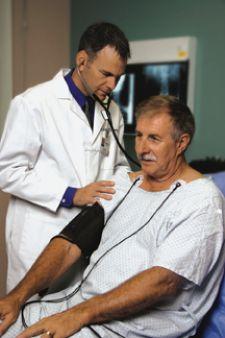
The community of Minden, NV, raised much of the support for a new freestanding ED.
In an effort to keep pace with the ever-growing demand for emergency care access, hospitals are turning to models of a freestanding emergency department (ED) to help ease overcrowding at hospital emergency rooms.
The freestanding ED is more than an “urgent care” center, having the same licensing, staffing and equipment as a traditional emergency room. Also, as with your traditional emergency room, a freestanding ED can’t turn away a patient. If an individual enters the facility seeking treatment then treatment must be provided, regardless of the individual's ability to pay. This requirement calls into question the ability of a freestanding ED to remain profitable.
Despite the questions that surround profitability, staffing and other variables, freestanding EDs are serving communities in Arizona, Texas, North Carolina, Nevada and several other states.
One is the Minden Emergency Care Center in Minden, NV. Owned by Carson Tahoe Hospital, this freestanding ED serves a rural area with a growing population. The facility's nurse manager, Sandy Wartgow, said back in the early 1980s members of the community wanted greater access to emergency healthcare than what was provided at the time and approached the hospital for help.
“The hospital equipped and staffed the facility, but much of the money needed to build the structure was raised by the community,” Wartgow recalled. “The community was instrumental in its creation.”
It's about 15 miles to the nearest hospital for most Minden residents, and Wartgow estimates the vast majority of cases seen are of the “urgent care” variety, but they treat about three to four higher acuity cases each day. Because the facility offers both urgent care and emergency care services, patients are not only diagnosed and treated according to their needs, but also charged accordingly. As with any business, the matter of payment raises the issue of how the operation can remain profitable.
Angie MacCabe, director of Outpatient Services for Carson Tahoe Hospital, said that, as with any healthcare operation, profit of margin is getting smaller and profitability is a constant struggle. However, in addition to typical cost controlling measures, the Minden facility remains open due in part to the outpatient services also offered at the facility.
“The labs and imaging services provided create a symbiotic relationship with our ED to offer a 'hub of healthcare' for patients,” said MacCabe. “There's no duplication of services, staffing is efficient and time is saved during patient registration if they used one of the other services because their history is already stored in our system.”
Staffing Not a Struggle
The Minden Emergency Care Center is staffed just like a hospital emergency room, with physicians and registered nurses — neither of which is required at an urgent care office. MacCabe acknowledged that the organization's big hospital struggles to find and keep qualified nurses, but there is no such shortage at the Minden facility. She estimates that almost 90 percent of staff who work there also live in the community.
Finding and keeping qualified staffing can be a challenge, and despite the shortage of registered nurses, medical professionals agree that more emergency care must be made available to keep up with demand. Donna Mason, president- elect of the Emergency Nurses Association, acknowledges that the competition for qualified nurses is high and this presents a “double-edged sword” in keeping up with the demand for healthcare.
“I've been a nurse for 31 years, 29 of those as an emergency nurse, and this is the worst shortage I've seen in years,” Mason said. “The ENA does not have a position specific to that of freestanding EDs, but like most associations of medical professionals we believe increased access to healthcare is an issue of vital importance.”
Not in My State
In some areas the struggle to keep up with the demand for emergency care faces more obstacles than just those of staffing and profitability. In California the path to providing increased access to ED care has met with considerable resistance.
According to Jim Lott, executive vice president of the Hospital Association of Southern California HASC, it took two years for the group's own membership to embrace this “radical concept” before HASC could attempt to move forward with legislation efforts. A bill aimed at authorizing a pilot program of freestanding EDs in California, and a second targeting the authorization to open such a facility at an existing clinic near Los Angeles International Airport were both defeated.
“We spent a good three years researching this issue and believed it was a good way to decompress the problems at overcrowded hospital emergency rooms,” Lott said. “We just couldn't overcome [negative] preconceived notions about an ED that wasn't connected to a hospital.”
Lott revealed that HASC member hospitals were leery of the concept because it might redirect business that would otherwise come into their emergency rooms. They also expressed concern that the larger healthcare providers who could afford to build and sustain such an operation would have an unfair advantage in the marketplace.
Embraced in NC
When planning its first freestanding ED in northern Wake County, NC, WakeMed Health and Hospitals’ officials anticipated some opposition from the state and business competitors. But according to Carolyn Knaup, who managed facility construction and its 2005 opening, there was little resistance from either.
The facility is licensed and staffed like a hospital emergency room, and competitors just didn't think this was the right niche in which to expand at the time. Since the opening of this freestanding ED, WakeMed has not experienced a decline in the number of cases it treats at its other emergency rooms.
The most important element was maintaining a relationship with the EMS, and establishing an understanding of the types of patients the new facility could handle, and which ones were to go directly to hospitals. However, in a pinch, the WakeMed North Healthplex could handle just about any emergency situation.
“Most EDs are at capacity, and the freestanding ED allows us to grow and expand our services,” she said.
WakeMed is expanding, with plans to open a second freestanding ED in an area southwest of Raleigh. The nearest hospital to this location is six miles away in Cary, and Knaup said that the ED is nearing its capacity and is in need of relief.
With the opening of its second facility WakeMed has shown that in the right market with the right services its model can be successful. In fact, Knaup estimates she responds to at least one call or e-mail each week from healthcare organizations around the country seeking insight into the model.
While models of the freestanding ED appear successful in Nevada, North Carolina and other states around the country, large markets in locations like Southern California are struggling to keep up with the demand for emergency care. Every night emergency rooms close their doors and patients are diverted around the city to the nearest open unit.
“The current diversion policies are just stop-gap measures,” Lott said. “Emergency room capacity is not expanding to meet the demand. Eventually [freestanding EDs] will have to be considered.”



 December 15, 2025
December 15, 2025 









